Blog
12 Easy Downloadable Resume Templates in
MS Word & LibreOffice Writer
Articles
Contents
- Overview
- Chronological Resumes
- How Applicant Tracking Systems Parse Chronological Resumes
- When to Use a Chronological Resume
- Chronological Resume Format
- View Chronological Resume Formats with Downloads
- Functional Resumes
- How Applicant Tracking Systems Parse Functional Resumes
- When to Use a Functional Resume
- Functional Resume Format
- When Not to Use a Functional Resume
- View Functional Resume Formats with Downloads
- Hybrid Resumes
- How Applicant Tracking Systems Parse Hybrid Resumes
- When to Use a Hybrid Resume
- Hybrid Resume Formats
- View Hybrid Resume Formats with Downloads
- Conclusion
Overview
Chronological, functional and hybrid are the three main formats for resumes. Chronological resumes emphasize work history in reverse chronological order by date. Functional resumes emphasize skills and deemphasize work history. Hybrid resumes combine elements of both the chronological and functional resume formats. This article contains four examples of each of the three resume formats available for downloading in Microsoft Office Word and LibreOffice Writer. The documents are simple table or paragraph templates that can be easily modified using the free version of Microsoft Word available at https://www.microsoft.com/en-us/microsoft-365/free-office-online-for-the-web" and LibreOffice Writer, which is free, open source and available at https://www.libreoffice.org/download/download-libreoffice/ . (Note: For your safety, use antivirus software to scan all downloads for malicious code and look at all URLs closely to ensure that one letter isn't added or omitted to spoof the website and capture your info.)
Generally, all three resume formats should use a standard typeface like Arial, Georgia, Helvetica, Times New Roman, Tahoma or Verdana. The type size should be 11 or 12 points. Use one-inch margins on all four sides and a lot of white space between headings and body text. Resumes should be limited to one page unless you have decades of experience. The downloadable resumes in this article are formatted with Arial 11-point typeface, one-inch margins on all four sides and .12 line spacing above and below headings, paragraphs and bullets. Margins, font size, line spacing, table cell margins, and font kerning are elements that can be modified to create more space or fill blank space in the templates.
The “Professional Summary” section of the chronological and functional resume formats should include both hard and soft skills. Hard skills are quantifiable abilities and knowledge like programming languages and computer applications whereas soft skills are behavioral traits such as interpersonal and communications skills. Begin every sentence in the “Professional Summary” section with an adjective describing your hard and soft skills (nouns). Examples: "Extensive web development experience with JavaScript, SQL, XML, HTML, and CSS" or "Comprehensive research and resolution of customer claims thereby improving customer service by [insert metric here]."
Use past tense verbs for past employment (or present tense verbs for current employment) descriptions of job responsibilities or accomplishments in the “Work History” section of the chronological and hybrid resume formats. If possible, include metrics in this section as well. Sales volume is not the only metric worthy of being included on a resume. Most industries use metrics to measure performance, impacts or outcomes. For example, use customer service call volume metrics, customer satisfaction metrics, warehouse production metrics, performance metrics, etc. wherever you can to optimize your resume and rank higher in Applicant Tracking Systems.
Lastly, never write in first person in a resume. In other words, never begin a sentence with "I" in a resume. Begin all sentences with adjectives and verbs. The cover letter is reserved for writing in first person. Even in a cover letter, try not to start every sentence with "I" because some recruiters and hiring managers will use that to determine specific personal traits.
Chronological Resumes
Chronological resumes emphasize work history in reverse chronological order by date beginning with the most recent or current job listed first. Recruiters are looking for company names, job titles, dates of employment and job duties or accomplishments with metrics. Chronological resumes present relevant information concisely in the context of work history and can be scanned quickly by headings and dates to provide brief overviews of candidates’ qualifications.
How Applicant Tracking Systems Parse Chronological Resumes
Applicant Tracking Systems (ATS) parse chronological resumes well. ATS parses and ranks resumes based on keywords and work history. Headings, subheadings and content are clear and in the expected format. Applicant Tracking Systems are programmed to look for keywords, job titles, and years of employment. Include keywords in the Summary paragraph at the top of the resume and in the body text where possible to rank higher in the candidate pool.
When to Use a Chronological Resume
Candidates whose work histories clearly demonstrate recent experience in the industry should use the chronological resume format. Candidates whose work histories show increased responsibility or promotions in the same line of work over time should also use the chronological resume format. Career changers can benefit from using the chronological resume format if their most recent work experience is relevant to the job they are applying for even if prior work experience is not relevant.
Chronological Resume Format
- Header: Include your full name and contact information with phone number, email and portfolio website at the top of the resume. List city and state with no street address (for your personal safety).
- Professional Summary: Create the "Professional Summary" section below the header and write a few sentences about your skills and attributes. Begin every sentence with an adjective that describes the skill or attribute (nouns). Include both hard and soft skills.
- Work History: List your work history in reverse chronological order beginning with your most recent job under the “Professional Summary” section. Create a text block for each job that includes company name, job title, and dates of employment. Under that text block, list your job duties, accomplishments and metrics in left-aligned bullet points so that it’s easy for a recruiter to scan down the left side of your resume to find relevant information quickly.
- Skills: Create a "Skills" section under the "Work History" section. Depending on the type of position you’re applying for, this section can be very brief with a two to three column bulleted list of hard skills such as computer programs or languages used in previous positions. Otherwise, use bulleted list sentences that include both hard and soft skills with respective impacts or outcomes.
- Education: Create the "Education" section under the “Skills” section. Include the institution name, degree type, major, and graduation date if recent (within three years). Add any honors or high GPAs in this section. Accounting and finance will want candidates’ GPAs while other industries like warehousing and customer service don’t care about GPAs.
- Certifications: List your certifications in the "Certifications" section under the “Education” section if applicable. Nurses and Firefighters are examples of candidates who would list certifications.
View Chronological Resume Formats with Downloads
Download links are below respective resume formats in both MS Word and LibreOffice Writer editable docs.
Chronological Resume Layout 1
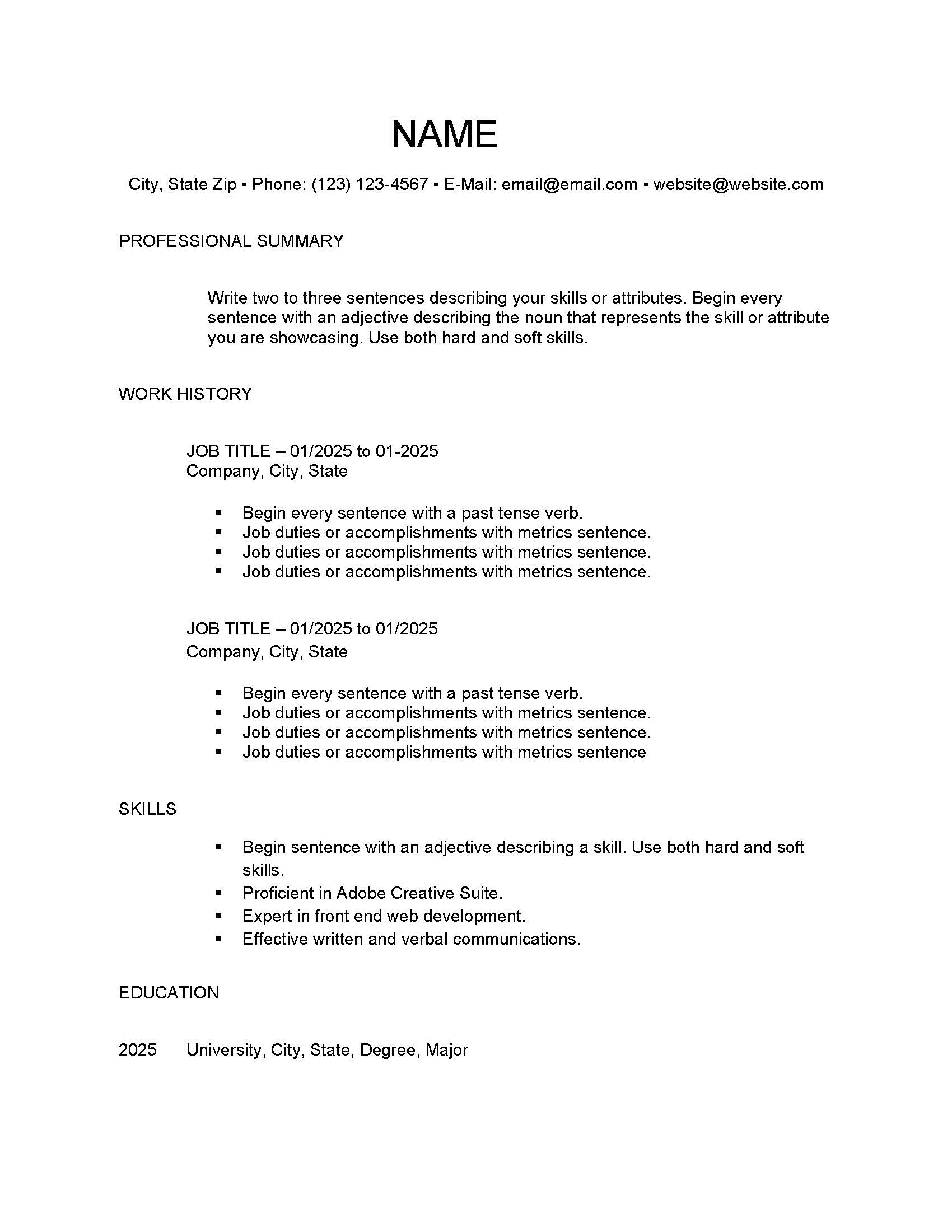
Download Chronological Resume Layout 1: MS Word
Download Chronological Resume Layout 1: OfficeLibre Writer
Chronological Resume Layout 2
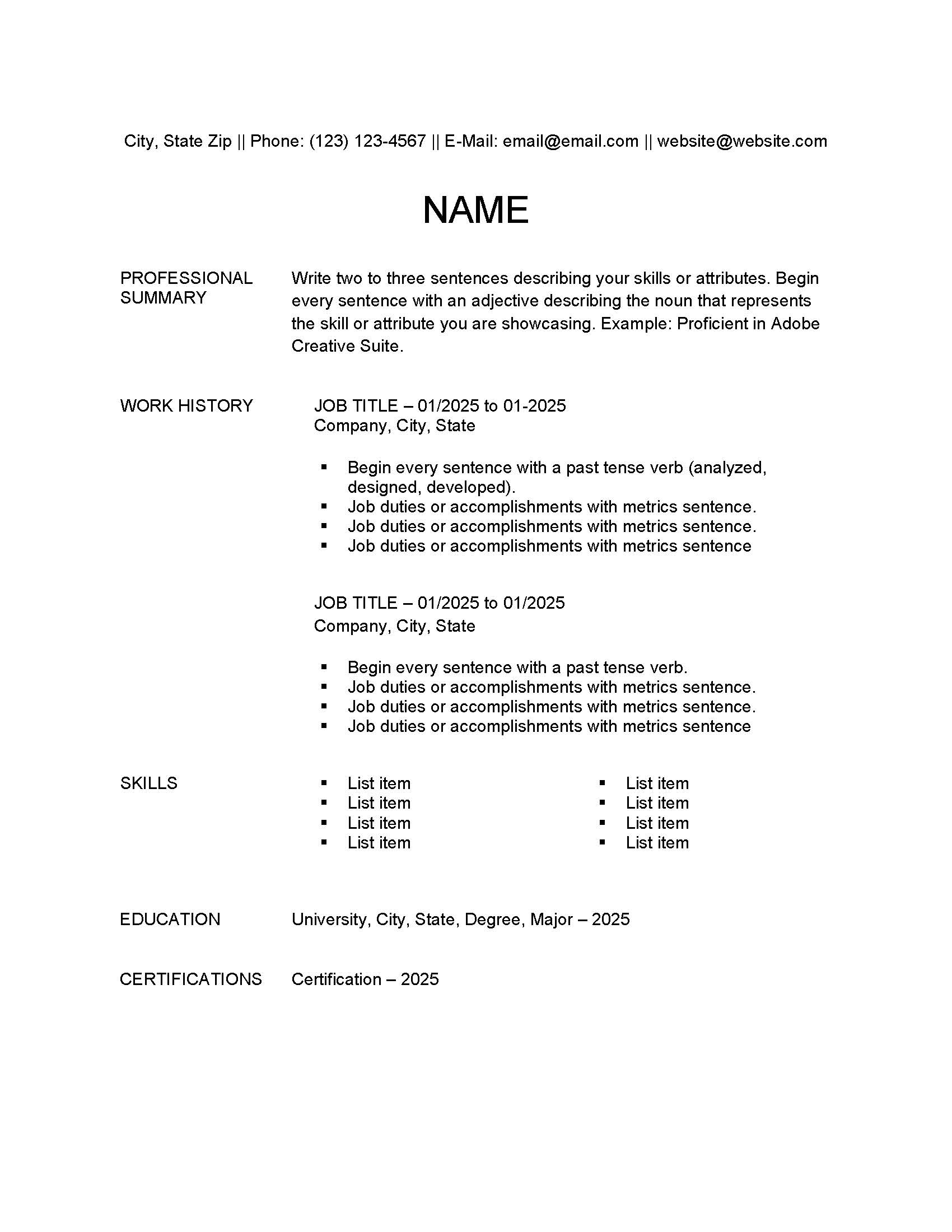
Download Chronological Resume Layout 2: MS Word
Download Chronological Resume Layout 2: OfficeLibre Writer
Chronological Resume Layout 3
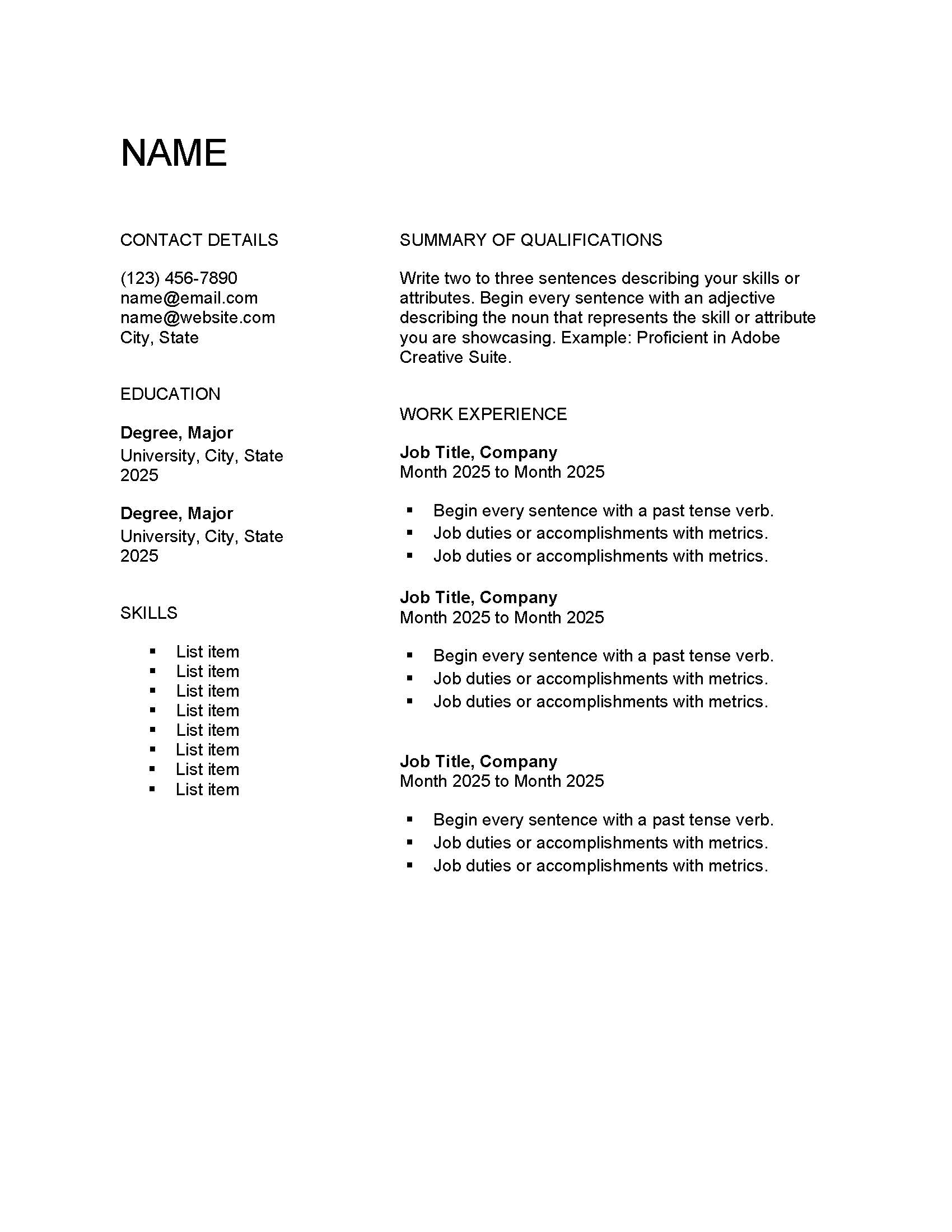
Chronological Resume Layout 3: MS Word
Chronological Resume Layout 3: OfficeLibre Writer
Chronological Resume Layout 4
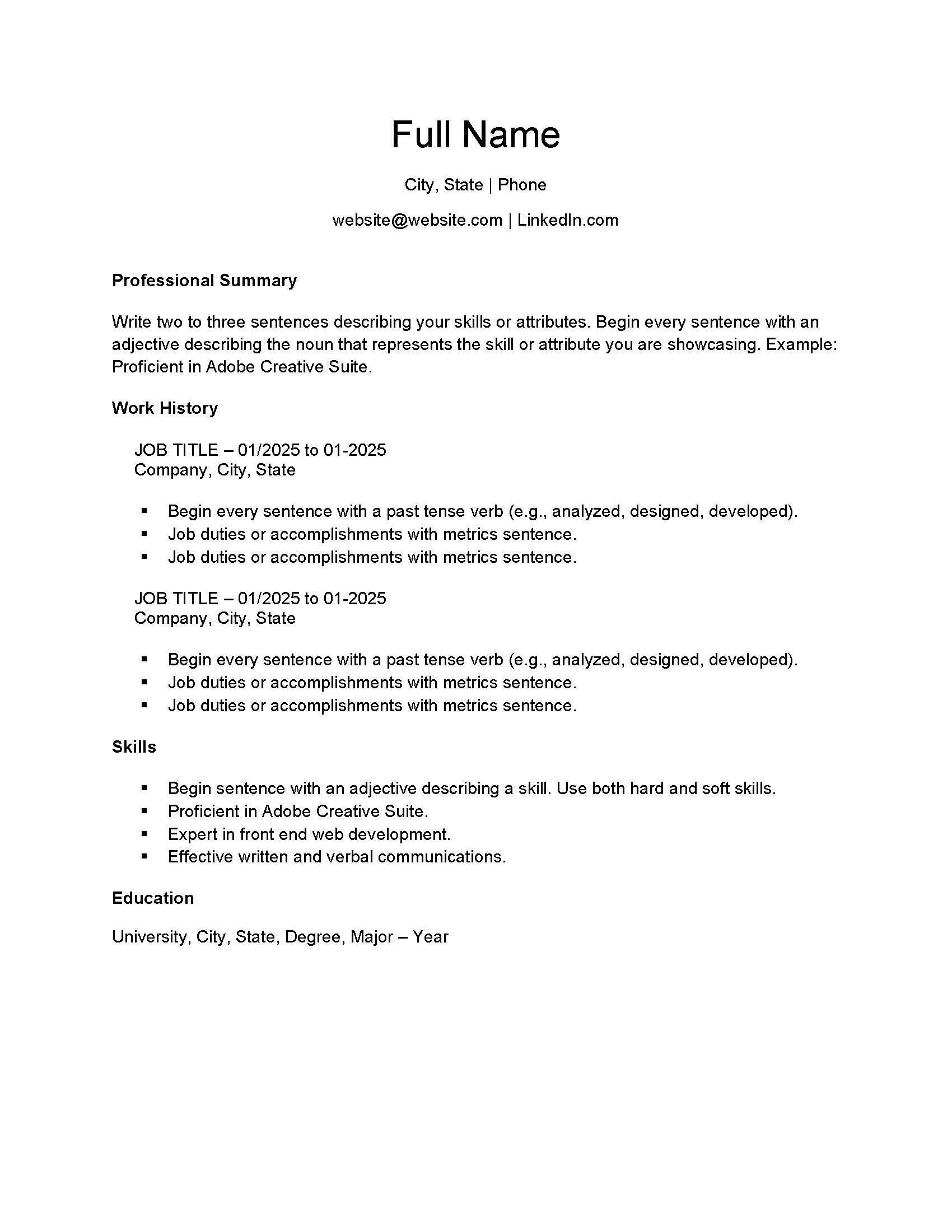
Chronological Resume Layout 4: MS Word
Chronological Resume Layout 4: OfficeLibre Writer
Functional Resumes
A functional resume or skills-based resume emphasizes skills and deemphasizes work history. The body of a functional resume highlights areas of expertise under a main heading such as “Relevant Skills” or “Professional Skills” with subheadings listing each major skill such as “Sales,” “Customer Service” or “Manufacturing” for example. Two to three descriptive sentences in bullet points describing job duties or accomplishments and metrics are listed directly under each skill. The purpose is to showcase skillsets instead of gaps in employment history or lack of experience that might be emphasized clearly in a chronological resume.
How Applicant Tracking Systems Parse Functional Resumes
Applicant Tracking Systems (ATS) do not parse functional resumes well and may omit a candidate from consideration entirely because candidates’ skills and experience are separated from the context of work history. For this reason, recruiters cannot determine how much experience candidates have with specific skills or how recently those skills have been used. Candidates might seem to be hiding a lack of qualifications or gaps in employment history by using the functional resume format. Therefore, functional resumes reduce candidates’ interview chances.
When to Use a Functional Resume
While a chronological resume is the preferred format for recruiters, candidates with no work history seeking entry level positions or those who have been out of the workforce for a long time might benefit from using the functional resume format. Additionally, functional resumes may be useful when candidates do not have traditional work histories. Volunteer work falls into this category.
Functional Resume Format
- Header: Insert your full name and contact information including phone, email, city and state and website portfolio link in the header at the top of the resume.
- Professional Summary: Add the “Professional Summary” section under the header section. This section is two to five sentences long using relevant keywords from the job posting that align with your skills, education, personal attributes and objectives.
- Relevant Skills: Add the “Relevant Skills” section followed by subheadings of major skills that you possess that match job posting keywords like “Customer Service,” “Technical Writing” or “Front End Web Development.” Under each subheading add two to three bullet points describing your major skill with accomplishments or achievements, how that skill was utilized and results. If you do not have any employment history, use subheadings like “Volunteer Experience,” “Special Projects” and “Technical Skills.” Then add two to three bullet points of descriptive sentences.
- Experience: Add the “Experience” or “Professional Experience” heading under the “Relevant Skills” heading. This section is very brief and includes only company names, job titles, locations and dates of employment with no descriptions of job duties or accomplishments. Some functional resume templates do not include dates of employment at all. That's a personal decision but there may be consequences attached to it.
- Education: Follow the "Experience" section with an “Education” section. List the institution, degree, graduation year if recent (within three years), honors and possibly GPA depending on the industry. Certifications can be listed in this section as well or under a separate “Certifications” heading under the “Education” heading.
When Not to Use a Functional Resume
Job seekers with clear career trajectories and job changers should not use functional resumes. Also, job seekers whose last job is relevant to the current job posting should not use the functional resume format. A hybrid resume format is optimal for these candidates because they have transferable skills and a clearly relevant work history even if there are short gaps in employment.
View Functional Resume Formats with Downloads
Download links are below respective resume formats in both MS Word and LibreOffice Writer editable docs.
Functional Resume Layout 1
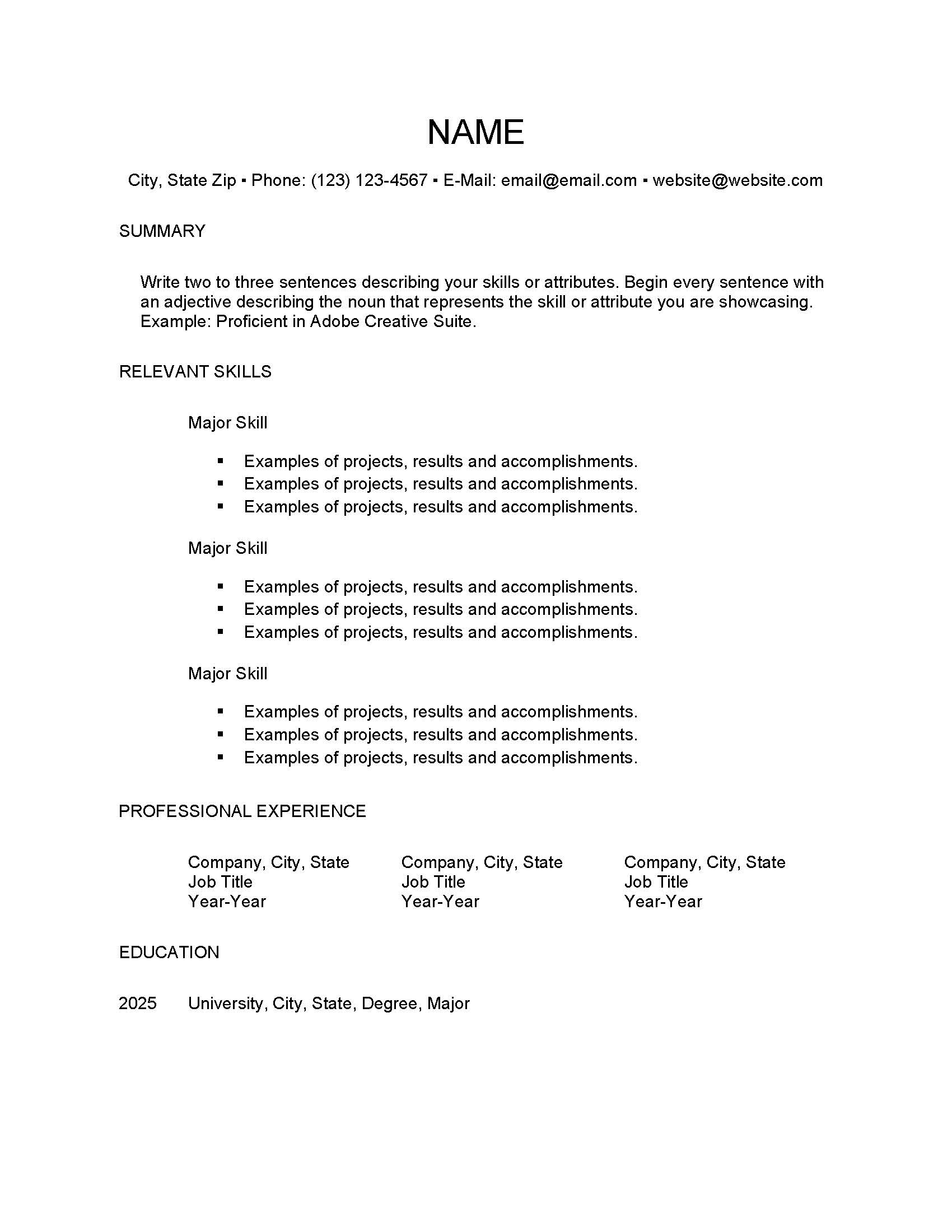
Download Functional Resume Layout 1: MS Word
Download Functional Resume Layout 1: OfficeLibre Writer
Functional Resume Layout 2
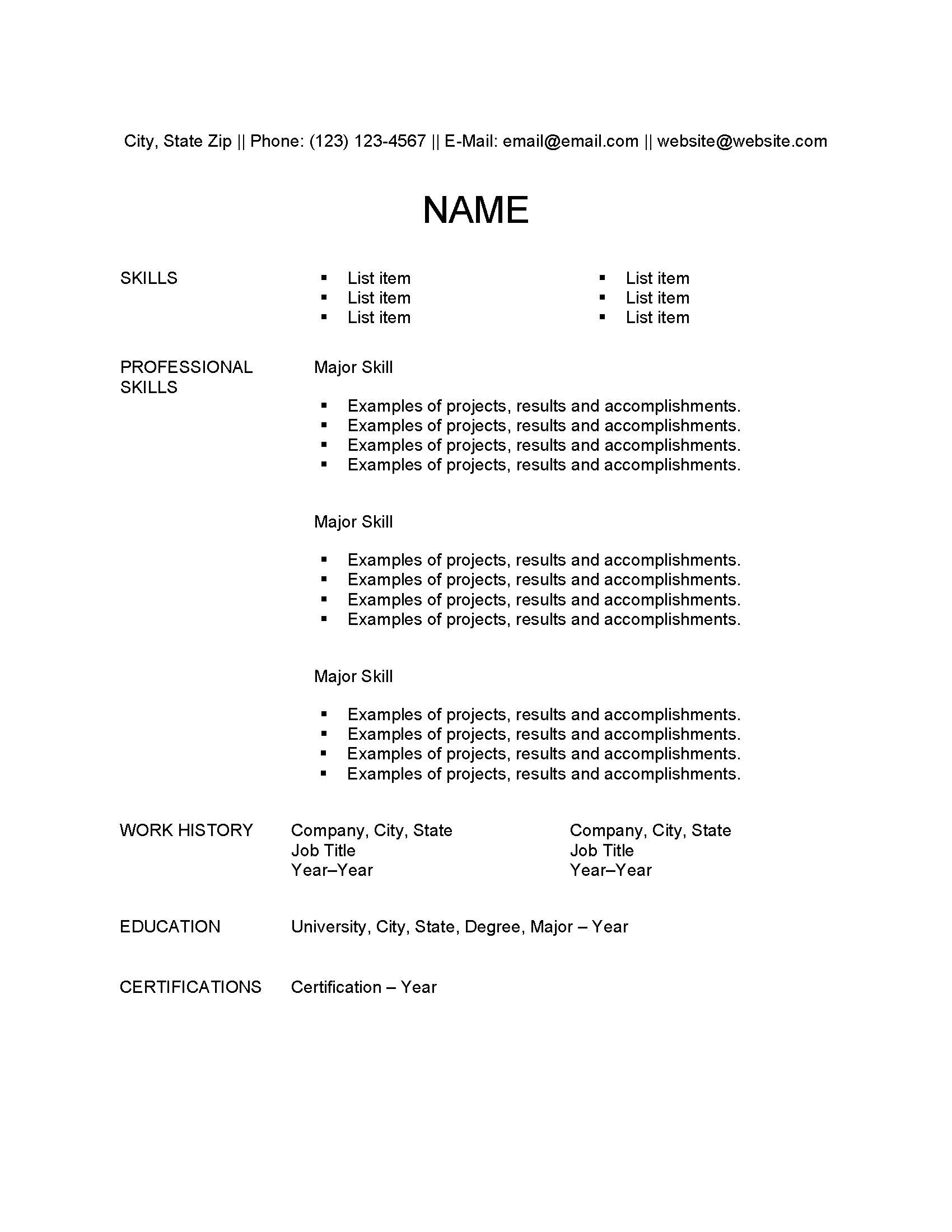
Download Functional Resume Layout 2: MS Word
Download Functional Resume Layout 2: OfficeLibre Writer
Functional Resume Layout 3
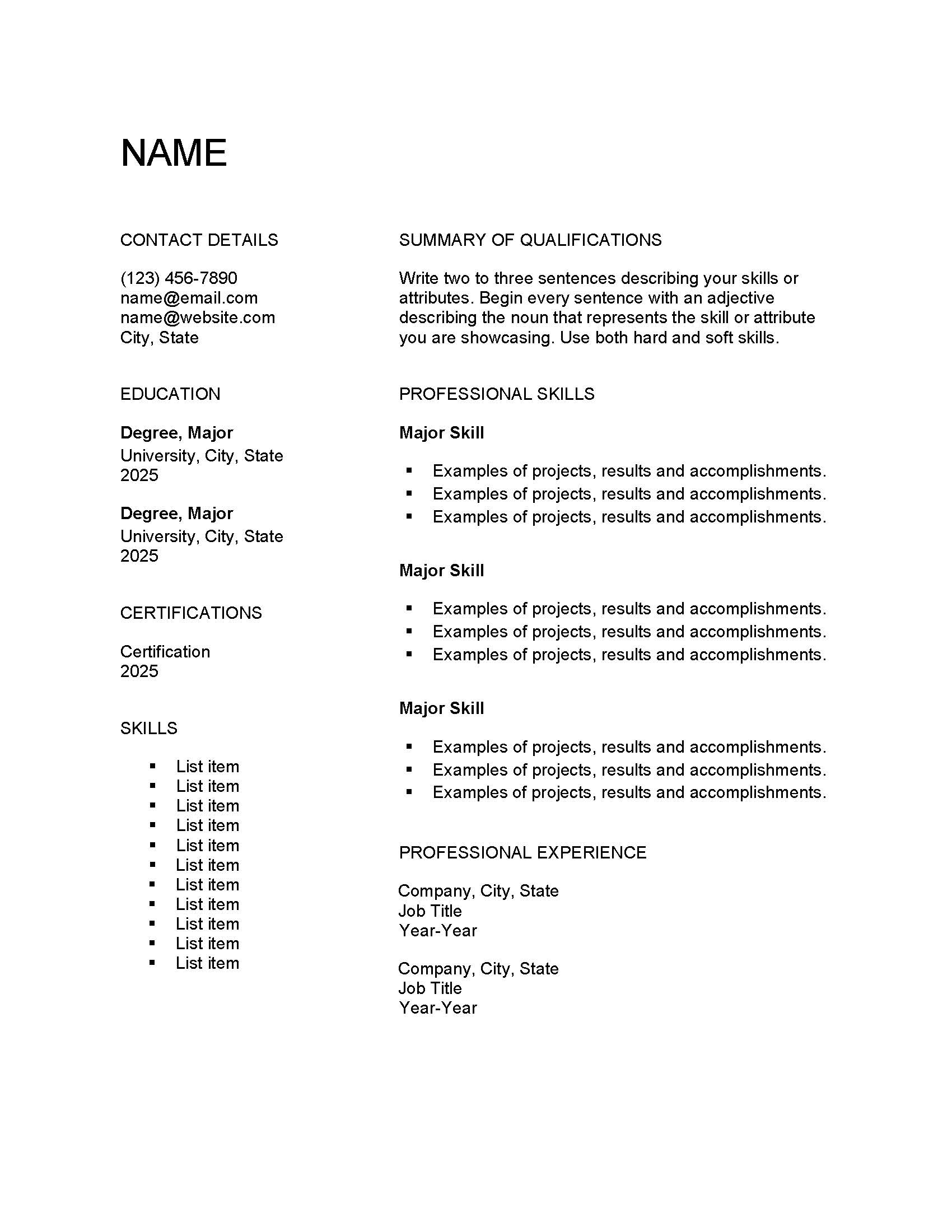
Download Functional Resume Layout 3: MS Word
Download Functional Resume Layout 3: OfficeLibre Writer
Functional Resume Layout 4
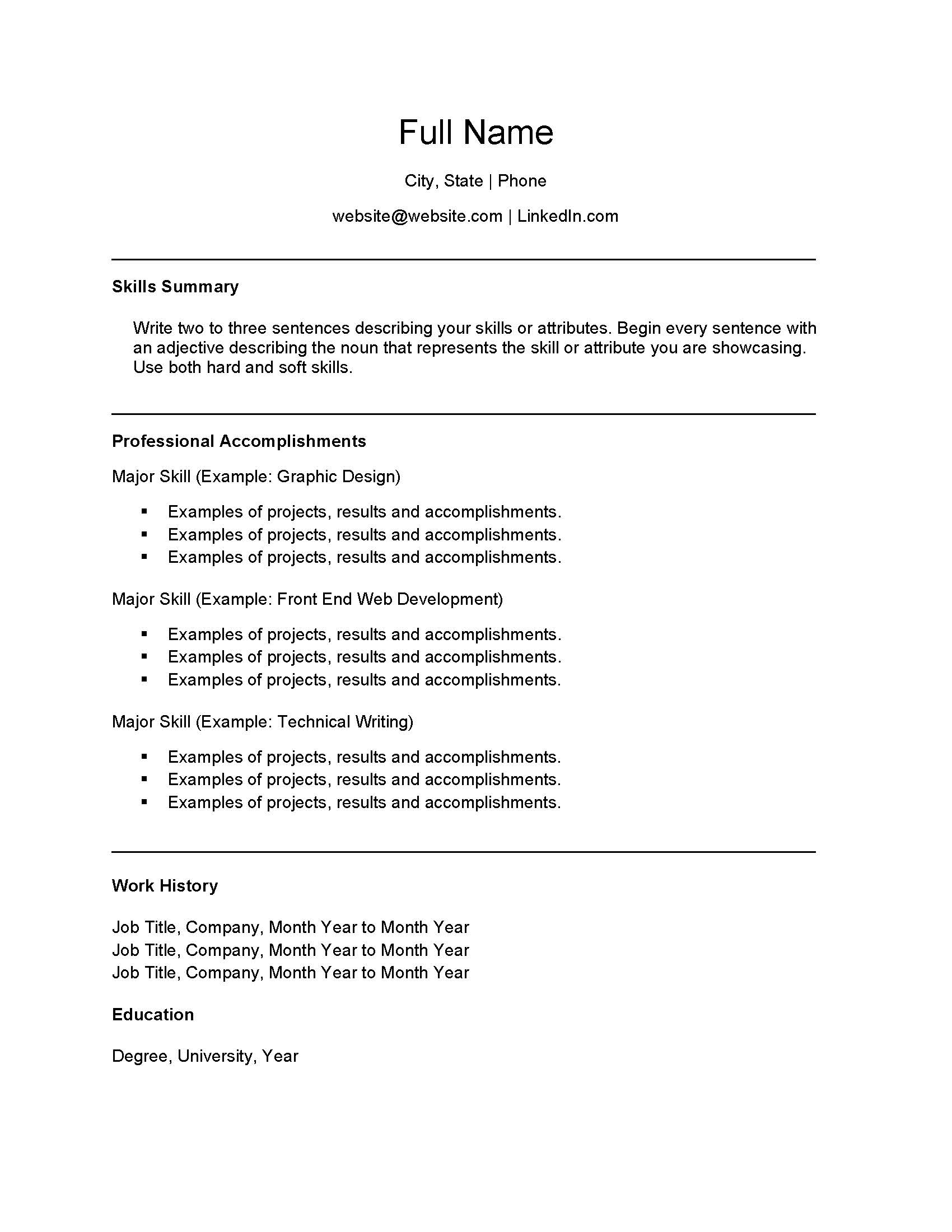
Download Functional Resume Layout 4: MS Word
Download Functional Resume Layout 4: OfficeLibre Writer
Hybrid Resumes
A hybrid resume is a combination resume that combines elements of both the chronological and functional resume formats. It begins with a “Skills” section and is followed by “Work History” and “Education” sections, respectively. Hybrid resumes highlight transferable skills and often omit the “Professional Summary” section included at the top of the page in both chronological and functional resumes.
How Applicant Tracking Systems Parse Hybrid Resumes
Applicant Tracking Systems (ATS) parse hybrid resumes as well as chronological resumes if clearly formatted and include standard section headings like “Skills,” “Work History” and “Education.” Include keywords in every section to optimize your resume for each job posting. Applicant Tracking Systems are programmed to look for keywords, job titles, and years of experience. Hybrid resumes include this information in the context of work history the same as chronological resumes do.
When to Use a Hybrid Resume
Hybrid resumes are used by job seekers who are changing careers or freelancers and independent contractors who have a lot of experience in various industries. College graduates who have transferable skills but not a lot of work experience other than internships or volunteer work also use this resume format. The hybrid resume format lets job seekers lead with strengths like leadership, project management or technical skills while demonstrating where, how and when that experience was gained. It emphasizes transferable skills in the context of work history to appeal to traditional recruiters who prefer chronological resumes.
Hybrid Resume Formats
- Header: Add your full name and contact information to this section at the top of the page. Include phone number, email, city and state and a portfolio website link in this section of the resume.
- Skills: Create the “Skills” section directly underneath the header section in place of the “Professional Summary” section. In this section create subheadings listing your major professional skills (Example: "Full-Stack Web Developer" or "Executive Assistant" or "Content Writer," etc.). Under each subheading add two to three bullet points describing your major skill with accomplishments or achievements, how that skill was utilized and results. List both hard and soft skills using the same keywords listed in the job posting.
- Work Experience: List your employment history in reverse chronological order beginning with your most recent job in the “Work Experience” section. Use two to three bullet points to describe job responsibilities and achievements. Where possible, add performance metrics.
- Education: Add the “Education” section under the "Work Experience" section of the hybrid resume. List your highest degree, type of degree, major, name and location of the institution and graduation date if recent (within three years). Certifications can be listed in this section as well or under a separate “Certifications” heading under the “Education” heading.
View Hybrid Resume Formats with Downloads
Download links are below respective resume formats in both MS Word and LibreOffice Writer editable docs.
Hybrid Resume Layout 1
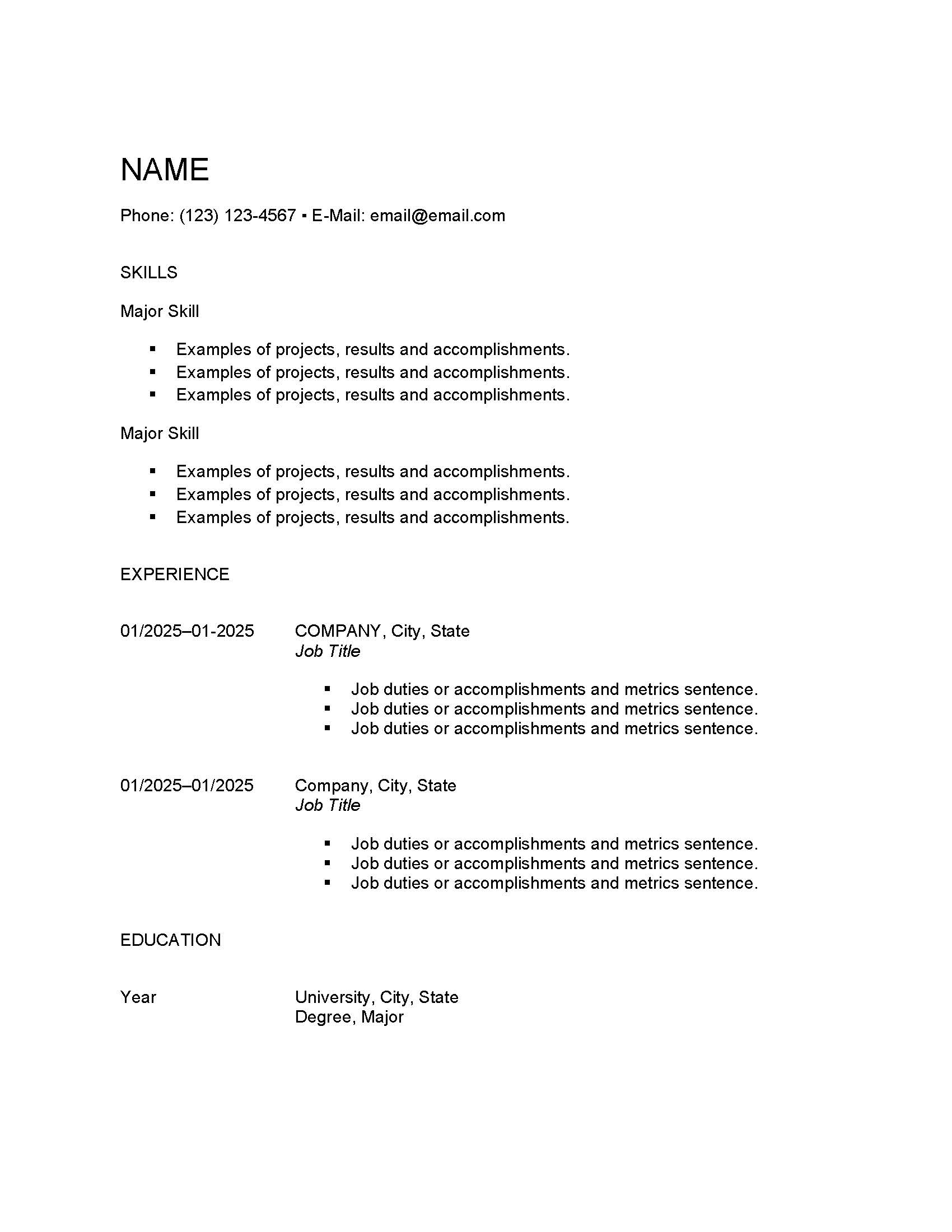
Download Hybrid Resume Layout 1: MS Word
Download Hybrid Resume Layout 1: OfficeLibre Writer
Hybrid Resume Layout 2
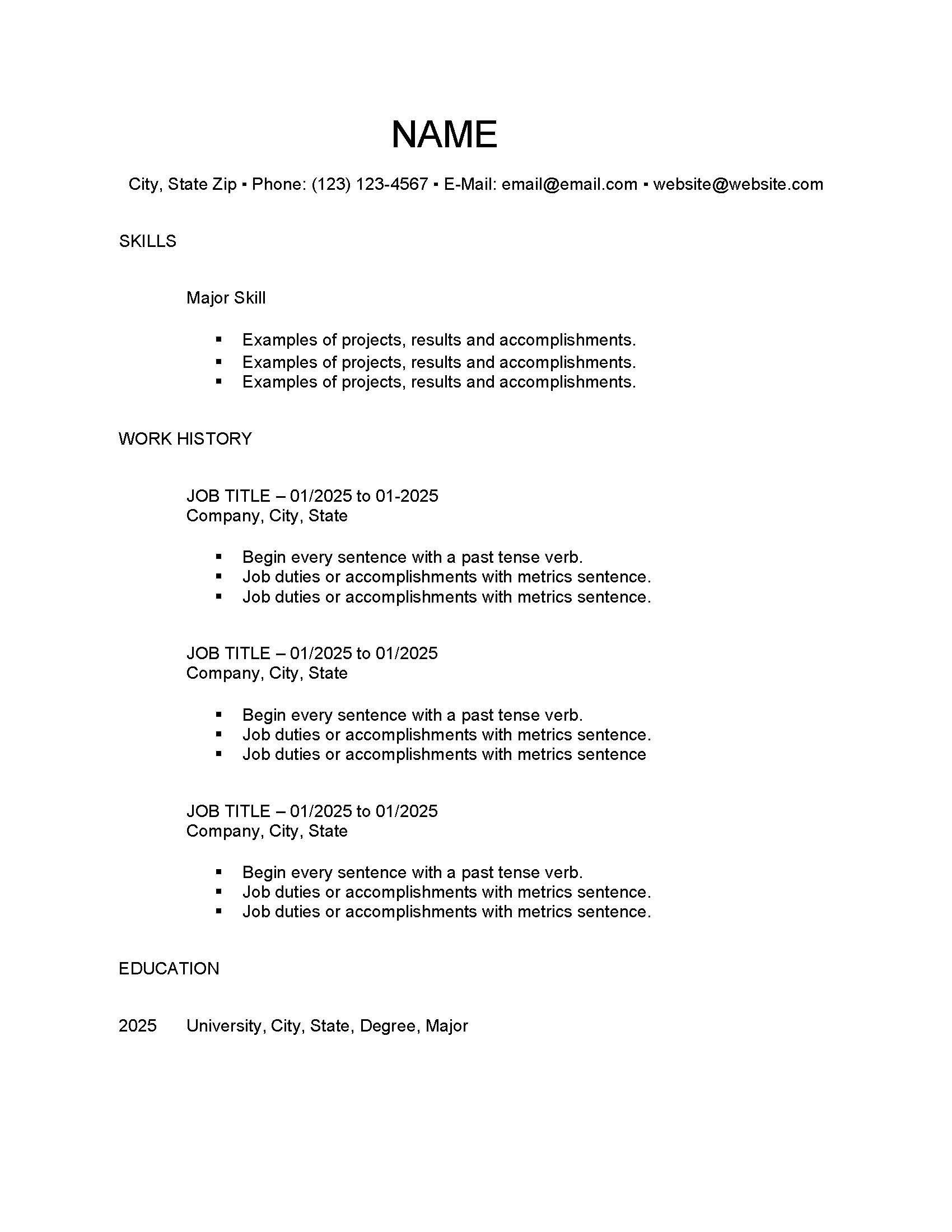
Download Hybrid Resume Layout 2: MS Word
Download Hybrid Resume Layout 2: OfficeLibre Writer
Hybrid Resume Layout 3
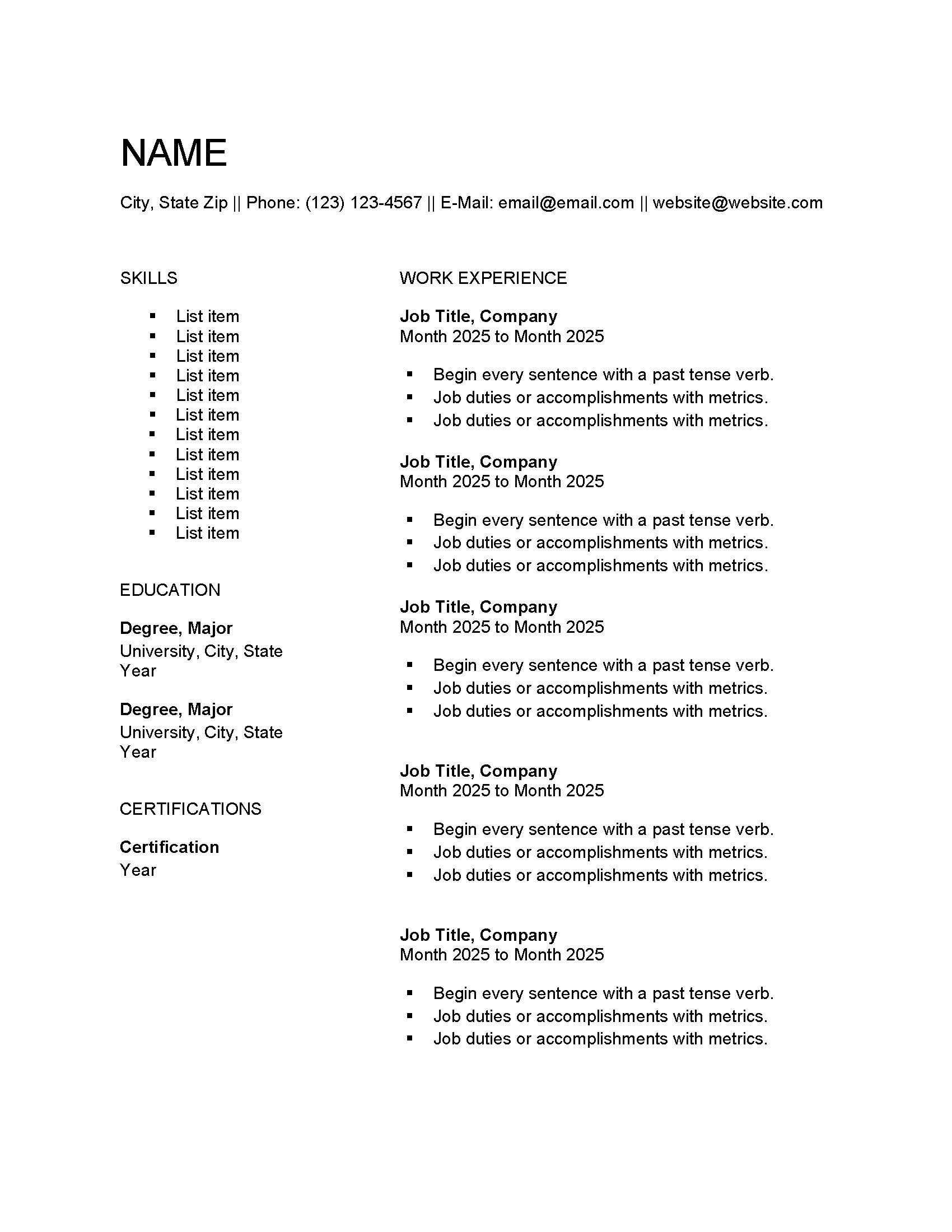
Download Hybrid Resume Layout 3: MS Word
Download Hybrid Resume Layout 3: OfficeLibre Writer
Hybrid Resume Layout 4
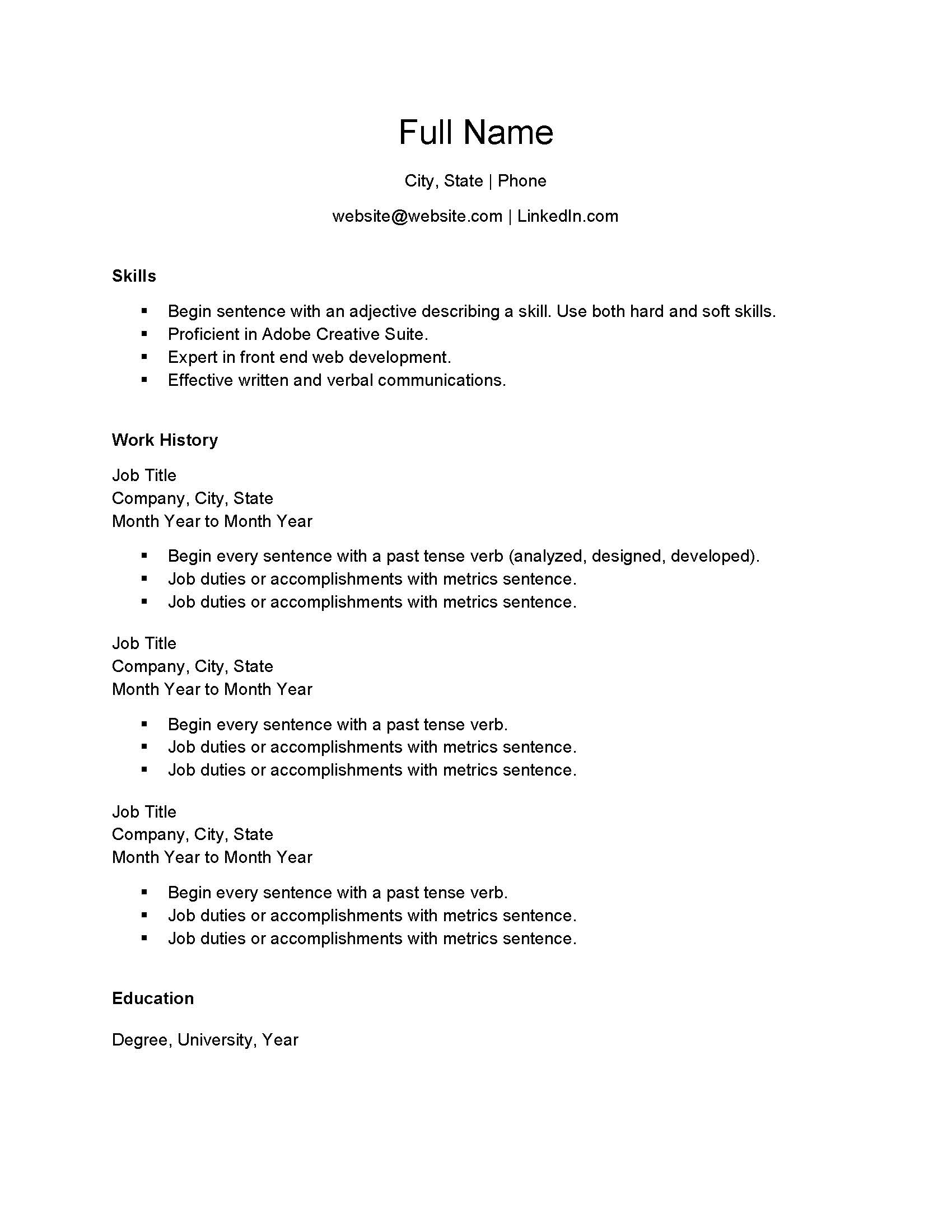
Download Hybrid Resume Layout 4: MS Word
Download Hybrid Layout 4: OfficeLibre Writer
Conclusion
Applicant Tracking Systems may not retain original resume formatting and may display resumes as plain text. Therefore, it is best to convert resumes to Portable Document Format (PDF) before uploading them to employer websites or job boards to retain original formatting. PDFs are easily parsed by ATS but are not editable by recruiters unless they have Adobe Acrobat. Recruiters from temp agencies often request resumes in MS Word so that they can remove candidates' contact information from the header to prevent potential clients from contacting candidates directly thereby circumventing temp agencies' services (and fees). Temp agencies are a good way to obtain experience for those with little to no experience, career changers or recent graduates. Temp agencies are also a good way for job seekers to get their foot in the door of large corporations that hire full-time, permanent employees from the temp pool based on performance. Just know that most temp agencies don't provide good benefits, if any, and take about 30 percent on average off the top of candidates' weekly pay.